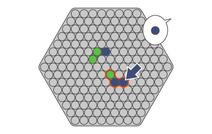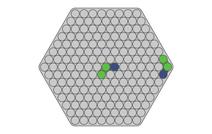Amusement
Sold Out
- celtis

ゲームを出しっぱなしにしていてもインテリアオブジェとして空間を演出することができます。
また、すべての駒は、使用後にケース内に収納することができます。

120度に折れ曲がった駒を交互に置いて、直線に7つ並んだほうが勝つゲームです。
自分の駒を置く時に、相手の駒を増やしてしまうところに、このゲームの奥の深さがあります。
・celtisは2名で対戦するゲームです。
・交互にゲーム盤上に駒を置き、相手より先に直線に七目を並べれば勝利です。
・1つの駒の2色三目は、表と裏で同色の目の数が異なります。自分の選んだ色が二目の面を使ってもかまわないですし、一目の面を使ってもかまいません。
・また、駒はゲーム盤から出なければ、盤のどこに置いてもかまいません。
・駒は、他の駒と隣接して置かなくてもかまいません。
・八目以上に並んでも、勝利になりません。








2006年 グッド・デザイン賞

| 定価 | ¥5,500(税込)※販売終了商品です。 |
|---|---|
| 品名 | celtis(ボードゲーム セルティス) |
| 品番 | 26100 |
| サイズ | W350mm × H20mm × D310mm |
| 材質 | ABS樹脂 |
| 重量 | 860g(セット合計) |
| 保証期間 | 商品購入から1年間 |
| セット内容 | ゲーム盤:1台 / ゲームコマ:58個 |
| パートナー企業 | 株式会社グルマンディーズ |



ボードゲームには相手がいる。そして、お互いがゲームをしたいと思わなければゲームは始まらない。「ボードゲームをする」という行為は、日常の行動の中に当てはまりにくい特殊な時空なのかも知れない。人が二人以上いてしかも目の前にきっかけがあるタイミングのみ、ボードゲームは成り立つような気がするのである。
そこで、いつも目に触れるところにあることが必要であると考え、出しっぱなしで仕舞わないインテリアボードゲームというプランを考えた。
オセロは最後までしないと勝負がつかない。チェスや囲碁や将棋は敷居が高く、構えてしまう。もっと、イージーなゲームを作りたい。碁石の五目並べが、気楽さという点で最も近いところであったが、それ以上の新しさが必要だった。
私は新たな駒のデザインを考えだすことで、新しい感覚の7目並べを考えることにした。そして、自分と相手の駒が一体化したカタチにたどり着いた。
自分の駒を布石する時に相手にも駒数を与えてしまうこと、この置き方によっては自分が不利になったりすることもあり、深い先読みが要求される。そして、短時間で勝敗が決まる、イージーで、インテリア性の高い新しいゲームが完成した。
 celtisをプレイする女の子。100% design in LONDONにて
celtisをプレイする女の子。100% design in LONDONにて

